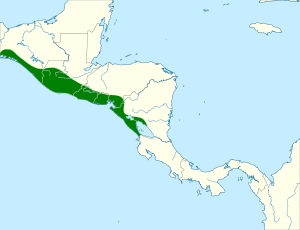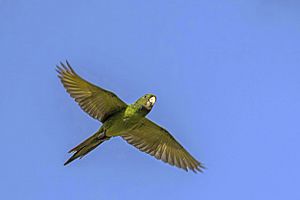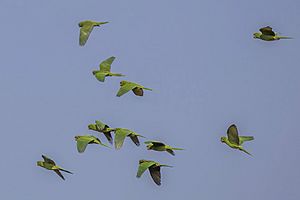Pacific parakeet facts for kids
Quick facts for kids Pacific parakeet |
|
|---|---|
 |
|
| Suchitepéquez Department, Guatemala | |
| Conservation status | |
| Scientific classification | |
| Genus: |
Psittacara
|
| Species: |
strenuus
|
 |
|
| Synonyms | |
|
P. holochlorus strenuus |
|
The Pacific parakeet (Psittacara strenuus) is a type of parrot found in Central America. People who keep birds sometimes call it the Pacific conure or Nicaraguan green conure. You can find this bird in countries like southern Mexico, Guatemala, El Salvador, Honduras, and Nicaragua.
Contents
About the Pacific Parakeet's Family Tree
The Pacific parakeet belongs to the parrot family, specifically a group called New World parrots. For a while, scientists placed it in a different bird group called Aratinga. However, since around 2013, it has been moved to its current group, Psittacara.
Scientists still discuss exactly how this bird fits into the larger bird family tree. Most major bird groups, like the International Ornithological Committee, see it as its own unique species. But another big group, BirdLife International, thinks it's actually a type of green parakeet.
What Does the Pacific Parakeet Look Like?
The Pacific parakeet is about 32 centimeters (12.6 inches) long. Both male and female birds look very similar.
They are mostly olive green, which looks a bit yellowish on their bellies. Some birds might have small red spots on their neck. The feathers under their wings and tail are olive-yellow.
Their eyes are orange-red and have a ring of pale, bare skin around them. Their beak is a horn color, and their legs and feet are brownish.
Where Do Pacific Parakeets Live?
The Pacific parakeet lives along the Pacific coast, starting from southern Mexico. Their home range goes south through Guatemala, El Salvador, and Honduras, all the way to central Nicaragua.
These birds live in many different kinds of forests and woodlands. This includes forests where trees lose their leaves, forests that stay green all year, and even swampy forests. They also live in dry, scrubby areas. You can find them in pine-oak forests in the mountains and even in city parks and gardens. They can live from sea level up to about 2,600 meters (8,500 feet) high.
Pacific Parakeet Behavior
Movement and Travel
Pacific parakeets do not migrate long distances. They stay in their home areas all year. However, they do move around locally to find food. This means they might fly to different spots depending on where they can find the most seeds and fruits.
What Do They Eat?
Scientists are still learning everything the Pacific parakeet eats. We know they eat seeds and fruits. Sometimes, they might eat crops from farms, which can be a problem for farmers. These parakeets often fly in large groups, sometimes with over 100 birds together!
Reproduction and Life Cycle
Not much is known about how Pacific parakeets raise their young. They have been seen nesting in cracks in rocks and in holes in dirt banks. They probably also nest in holes in trees and in large termite nests. It seems their breeding season is usually from June to September.
How Do They Talk?
When Pacific parakeets fly, their call sounds like "kreh!-kreh!-kreh!-kreh!...". When they are sitting still, their call is deeper and sounds like a scratchy "kreeh-kreeh-kreeh-kreei-kreei".
Pacific Parakeet Status
The IUCN (International Union for Conservation of Nature) keeps track of how many animals are left in the wild. They consider the Pacific parakeet to be of "Least Concern." This means they are not currently in danger of disappearing.
Scientists estimate there are about 200,000 adult Pacific parakeets. Their numbers are slowly going down, but there are no big threats right now. They are quite common in some parts of their home range. They also live in at least two protected areas, which helps keep them safe.
See also
 In Spanish: Periquito pacífico para niños
In Spanish: Periquito pacífico para niños



